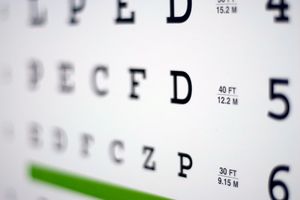We've all heard the expressions twenty-twenty vision and visual acuity. As frequently used as these terms may be, do people really know their meaning? When you have a proper understanding of these terms, you will know why an eye care professional needs you to do more than simply read from an eye chart.
20/20 vision actually refers to the accuracy of vision measured at a distance of 20 feet. When you have 20/20 vision, that means that from a distance of 20 feet you're able to properly see that which should be seen from that distance. 20/20 is just a standard measurement. A large number of people can even see better than 20/20; for example, vision that measures 20/15, so what they could see at 20 feet, a person with normal vision would only be able to discriminate as close as 15 feet.
Each eye is evaluated on its own. When you're asked to look at the eye chart and read out the letters, the smallest row that you can read properly indicates the visual acuity in the eye being examined.
But 20/20 eyesight actually doesn't mean your vision is perfect, because, after all, it can only judge your clarity of vision at a distance. There are other really crucial sight skills; the ability to focus on objects in your immediate surroundings, contrast sensitivity, peripheral vision, depth perception, eye coordination and color vision - these are all really important to your overall eyesight. Also, someone who has 20/20 vision can have unhealthy eyes. Even those who have suffered damage to the nerves within their eyes from diabetes, high blood pressure, glaucoma, or a range of other diseases are still able to have 20/20 vision without needing to wear eye glasses. This is why an optometrist should always conduct a comprehensive eye exam, as opposed to just a plain eye chart test.
When you're having your next eye exam, you'll understand why you're being told to read letters off an eye chart, and more!





Our office is open every other Saturday from 8:30am–1:30pm